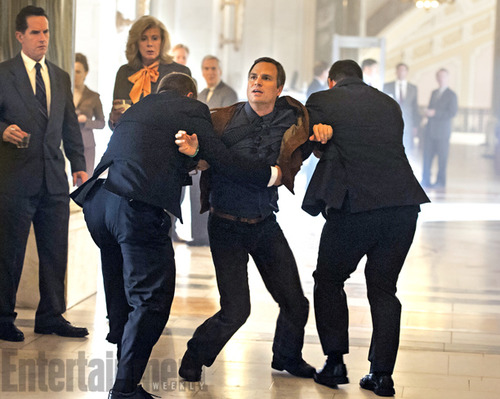 HBO clears its Sunday night deck of acclaimed shows to present another prestige product — an Emmy sure thing from the network that made “And The Band Played On” to “Angels in America.”
HBO clears its Sunday night deck of acclaimed shows to present another prestige product — an Emmy sure thing from the network that made “And The Band Played On” to “Angels in America.”
Larry Kramer’s play “The Normal Heart” (HBO, 9 p.m.) fits right into that pantheon of works that reflect the medical scourge that felt like a persecution to gay men who were its early targets. The adaptation into film by Ryan Murphy who has turned into an assured director from his work on “Glee” to “American Horror Story” does a good job in bringing urgency to the heartbreaking story, with a superlative cast.
Mark Ruffalo brings his best work, bringing a noisy energy to his character that is justified by the epidemic all around him. Like a number of strong, recent documentaries that have returned to vivid life those early days of panic and hatred, “The Normal Heart” reminds us how timid politicians were even to say the world AIDS, but also how organizations of gay men were hesitant to put the word “gay” on envelopes out of fear of reactions.
Jim Parson reprises his own role from the play, in a cast that also includes Matt Bomer, Taylor Kitsch, Alfred Molina and a real movie star, Julia Roberts, who portrays a polio-stricken doctor who is one of the first to treat those with HIV-AIDS.
“I have been asked twice before to play this part and both times turned it down, not only because of just conflicts of time but my inability to fully understand who this character was,” Roberts told reporters at the TV Critics Association winter press tour in January. “I ended up watching a documentary on polio, which I’m too young to remember what that experience was like for the country, for the world, and it unlocked the door to who this woman is to me and where her ferocious, relentless pursuit of correctness comes from, and that’s when Ryan received what he always gets, which is the answer he wants. And it was just such a beautiful experience to get to play her and to get to pay tribute to a person who never let anything stand between her and the right thing to do for someone else.”
For Murphy, it was a longtime dream to adapt the play. “I really actively pursued the play from Larry, and I bought the play I think in 2010,”he said. “It was just a passion project of mine, and it’s a play that I had loved even when I was in college. And I flew myself out, and I met with him when it became available, and he liked my take on it, so he sold it to me.”
After three years of work, Murphy said, “there’s probably 40 to 45 percent new material in the movie, and that’s something that he worked really hard on sort of making a really epic story. It takes place from ’81 to ’84, and the I think first ten minutes of the movie, for example, is all shot on location at Fire Island at the places where the guys really went, the parties they really went to.”
It’s a period he remembers, but not all in the cast do.
“I remember frightening ’20/20’s when I was like 10 and 11,” Parsons said, “and so doing the play especially, because it was the first time I was introduced to the material, I found it it was a real education for me.”
But for Bomer, who plays a New York Times reporter, “this play was actually the first exposure I really had, a real understanding of the illness that I had. I read it in the closet of my drama room when I was 14 years old.
“And,” he added, “the irony of that is not lost on me.”
For Murphy, making the film was personal.
“I really came of age in this period, and I lost a lot of friends to AIDS, and I can remember one of my best friends at the time died in the mid-’90s. He was fired. His parents ostracized him, and he was so stigmatized by it that even on his death bed he would not admit that that’s what he was dying of. So it was a very painful thing for me growing up, and I don’t really know the answer to that question directly other than I just really tried to be true to those boys who lost so much that I feel I owe so much.
“I’m married, and I have a child, and I feel like this movie really is a civil rights movie, and I feel like what those seven guys did and Emma did in that fight really paved the way for the life that I have today, so I sort of feel very indebted to them. And I just think it’s a very painful chapter in our lives.
“At the end of the movie we talk about President Reagan and his legacy, and Ed Koch and his legacy, and nobody was really doing anything. And as a result, history shows you that something that probably could have become much less tragic ballooned into a worldwide epidemic,” Murphy said. “I feel like the issues that those guys were battling about and battling against are exactly the same ones that I feel we’re still fighting against, so it does feel modern in that the more things change, the more they stay the same.
Which is why I think the movie is so sad ultimately and yet hopeful at the end,” he said. “Because there are people who were fighting to change the world.”